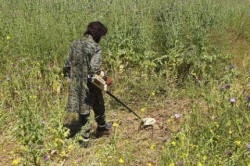|
 Five
million Syrians at high risk of explosive weapons: study Five
million Syrians at high risk of explosive weapons: study
 Send a link to a friend
Send a link to a friend
[May 12, 2015] BEIRUT
(Reuters) - About 5.1 million Syrians are living in areas at high risk
from explosive weapons, some of which fail to detonate and so will pose
a deadly threat for years to come, aid group Handicap International
said.
|
|
 The global charity examined 78,000 violent incidents in Syria's war
between December 2012 and March 2015 and found that more than 80
percent involved highly destructive weapons like rockets, mortars
and bombs, rather than light arms. The global charity examined 78,000 violent incidents in Syria's war
between December 2012 and March 2015 and found that more than 80
percent involved highly destructive weapons like rockets, mortars
and bombs, rather than light arms.
"Syria will inherit the deadly legacy of explosive weapons for
years," said Anne Garella, Regional Coordinator of Handicap
International.
The conflict is in its fifth year, having killed more than 220,000
people, according to a U.N. estimate. More than 1.5 million people
have been injured, according to the Syrian Observatory for Human
Rights, an organization that monitors the war.

Diplomatic efforts aimed at finding a political solution have gone
nowhere.
A range of insurgent groups have been battling the Syrian military
and allied fighters. U.S.-led air forces have been bombing ultra
hardline Islamic State militants since last summer.
The Handicap International study found that three-quarters of the
incidents it recorded took place in populated areas like larger
towns and cities.
"This suggests that belligerents have no intention of effectively
distinguishing between civilians and combatants -- which constitutes
a violation of international humanitarian law," said the group,
which provides aid to disabled people in conflict and disaster
zones.
[to top of second column] |

The heavily-populated western provinces of Aleppo, Deraa, Homs,
Idlib and Rural Damascus were the most affected, the study found.
The research was based news reports, social media and data from the
United Nations and non-governmental organizations.
(Reporting by Sylvia Westall; editing by Andrew Roche)
[© 2015 Thomson Reuters. All rights
reserved.] Copyright 2015 Reuters. All rights reserved. This material may not be published,
broadcast, rewritten or redistributed.
 |